Special Report
This Is the City in Every State Where COVID-19 Is Growing the Fastest
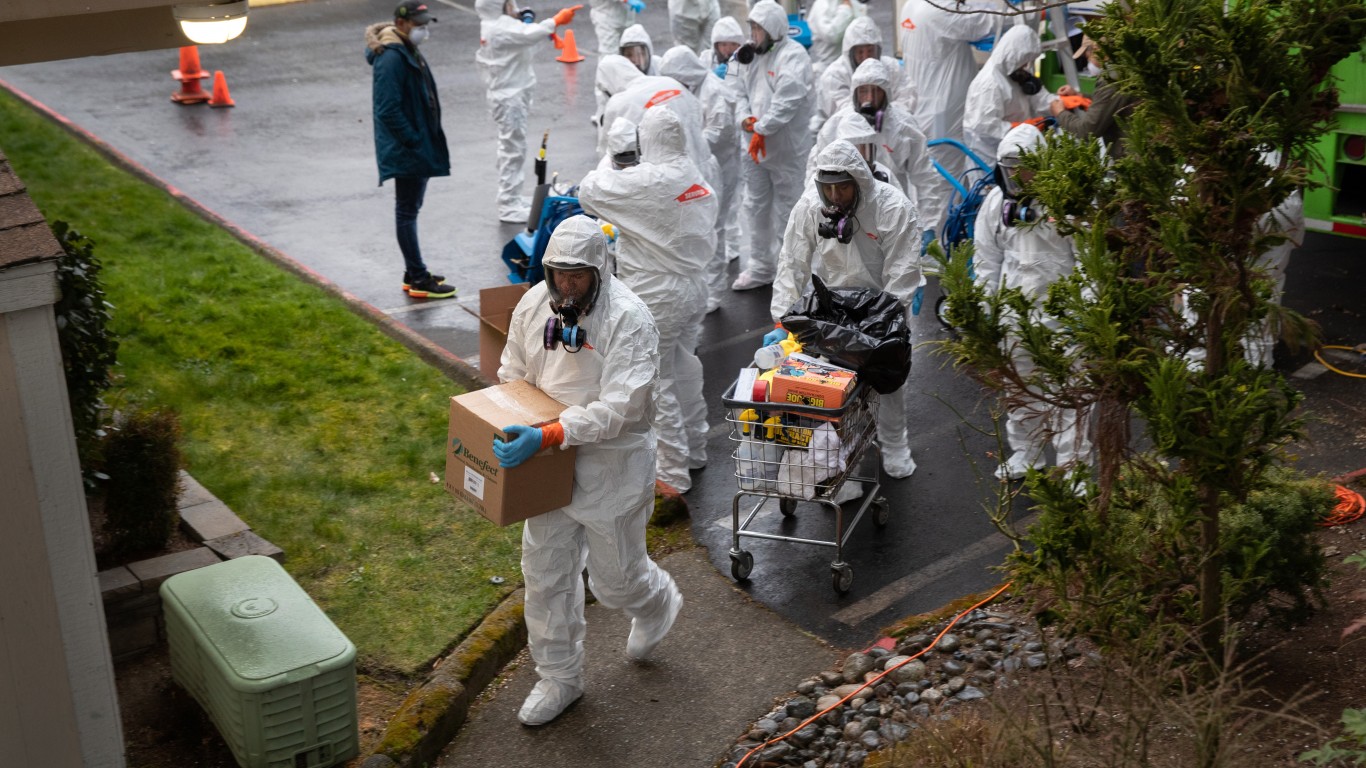
Published:
Last Updated:

The U.S. has reported more than 85.6 million confirmed COVID-19 cases as of June 28. There have been more than 1,005,000 reported deaths from COVID-19-related causes — the highest death toll of any country.
The extent of the spread of the novel coronavirus continues to vary considerably from state to state, and from city to city. Even as the number of daily new cases is flattening or even declining in some parts of the country, it is surging at a growing rate in others.
Nationwide, the number of new cases is growing at a steady rate. There were an average of 26.9 daily new coronavirus cases per 100,000 Americans in the week ending June 28, essentially unchanged from the week prior, when there were an average of 29.5 daily new coronavirus cases per 100,000 people.
Metropolitan areas with a high degree of mobility and a large population may be particularly vulnerable to outbreaks. While science and medical professionals are still studying how exactly the virus spreads, experts agree that outbreaks are more likely to occur in group settings where large numbers of people routinely have close contact with one another. Cities with high concentrations of dense spaces such as colleges, correctional facilities, and nursing homes are particularly at risk.
The city with the highest seven-day average of new daily COVID-19 cases per capita is in Hawaii. In the Urban Honolulu, HI, metro area, there were an average of 61.1 daily new coronavirus cases per 100,000 residents in the week ending June 28, the most of any U.S. metro area. Other cities where COVID-19 is growing the fastest include Miami-Fort Lauderdale-Pompano Beach, FL; Kahului-Wailuku-Lahaina, HI; and Greenville, NC.
To determine the metropolitan area in each state where COVID-19 is growing the fastest, 24/7 Wall St. compiled and reviewed data from state and local health departments. We ranked metropolitan areas according to the average number of new daily COVID-19 cases per 100,000 residents in the seven days ending June 28. Data was aggregated from the county level to the metropolitan area level using boundary definitions from the U.S. Census Bureau. Population data used to adjust case and death totals came from the U.S. Census Bureau’s 2019 American Community Survey and are five-year estimates. Unemployment data is from the Bureau of Labor Statistics and is seasonally adjusted.

Alabama: Tuscaloosa
Avg. new daily cases in Tuscaloosa in week ending June 28: 41.1 per 100,000
Avg. new daily cases in Tuscaloosa in week ending June 21: 26.7 per 100,000
COVID-19 cases in Tuscaloosa as of June 28: 70,659 (28,186.8 per 100,000)
Peak pandemic unemployment in Tuscaloosa: 17.1% (April 2020)
Tuscaloosa population: 250,681 (71.7 people per sq. mi.)

Alaska: Fairbanks
Avg. new daily cases in Fairbanks in week ending June 28: 42.8 per 100,000
Avg. new daily cases in Fairbanks in week ending June 21: 39.7 per 100,000
COVID-19 cases in Fairbanks as of June 28: 29,512 (29,788.4 per 100,000)
Peak pandemic unemployment in Fairbanks: 11.4% (April 2020)
Fairbanks population: 99,072 (13.5 people per sq. mi.)
These are all the counties in Alaska where COVID-19 is slowing (and where it’s still getting worse).

Arizona: Flagstaff
Avg. new daily cases in Flagstaff in week ending June 28: 39.9 per 100,000
Avg. new daily cases in Flagstaff in week ending June 21: 46.6 per 100,000
COVID-19 cases in Flagstaff as of June 28: 45,964 (32,535.4 per 100,000)
Peak pandemic unemployment in Flagstaff: 17.9% (April 2020)
Flagstaff population: 141,274 (7.6 people per sq. mi.)
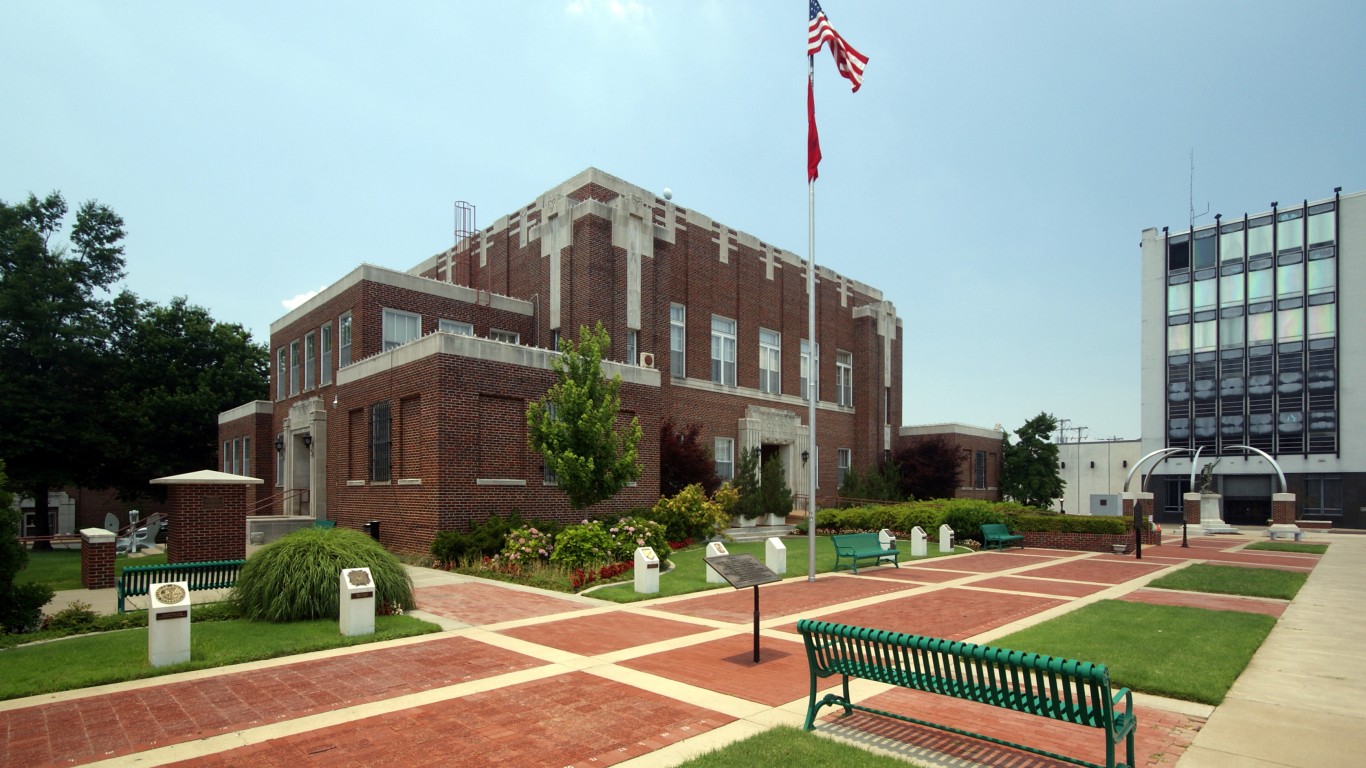
Arkansas: Jonesboro
Avg. new daily cases in Jonesboro in week ending June 28: 29.6 per 100,000
Avg. new daily cases in Jonesboro in week ending June 21: 28.4 per 100,000
COVID-19 cases in Jonesboro as of June 28: 46,946 (35,770.8 per 100,000)
Peak pandemic unemployment in Jonesboro: 9.3% (April 2020)
Jonesboro population: 131,241 (89.5 people per sq. mi.)

California: San Jose-Sunnyvale-Santa Clara
Avg. new daily cases in San Jose in week ending June 28: 46.1 per 100,000
Avg. new daily cases in San Jose in week ending June 21: 56.3 per 100,000
COVID-19 cases in San Jose as of June 28: 401,234 (20,184.4 per 100,000)
Peak pandemic unemployment in San Jose: 12.0% (April 2020)
San Jose population: 1,987,846 (742.1 people per sq. mi.)

Colorado: Fort Collins
Avg. new daily cases in Fort Collins in week ending June 28: 52.6 per 100,000
Avg. new daily cases in Fort Collins in week ending June 21: 73.7 per 100,000
COVID-19 cases in Fort Collins as of June 28: 88,479 (25,662.0 per 100,000)
Peak pandemic unemployment in Fort Collins: 11.2% (April 2020)
Fort Collins population: 344,786 (132.8 people per sq. mi.)

Connecticut: Norwich-New London
Avg. new daily cases in Norwich in week ending June 28: 15.0 per 100,000
Avg. new daily cases in Norwich in week ending June 21: 18.0 per 100,000
COVID-19 cases in Norwich as of June 28: 61,467 (22,987.8 per 100,000)
Peak pandemic unemployment in Norwich: 15.0% (May 2020)
Norwich population: 267,390 (402.2 people per sq. mi.)

Delaware: Dover
Avg. new daily cases in Dover in week ending June 28: 30.0 per 100,000
Avg. new daily cases in Dover in week ending June 21: 32.5 per 100,000
COVID-19 cases in Dover as of June 28: 54,929 (31,086.2 per 100,000)
Peak pandemic unemployment in Dover: 17.3% (May 2020)
Dover population: 176,699 (301.4 people per sq. mi.)
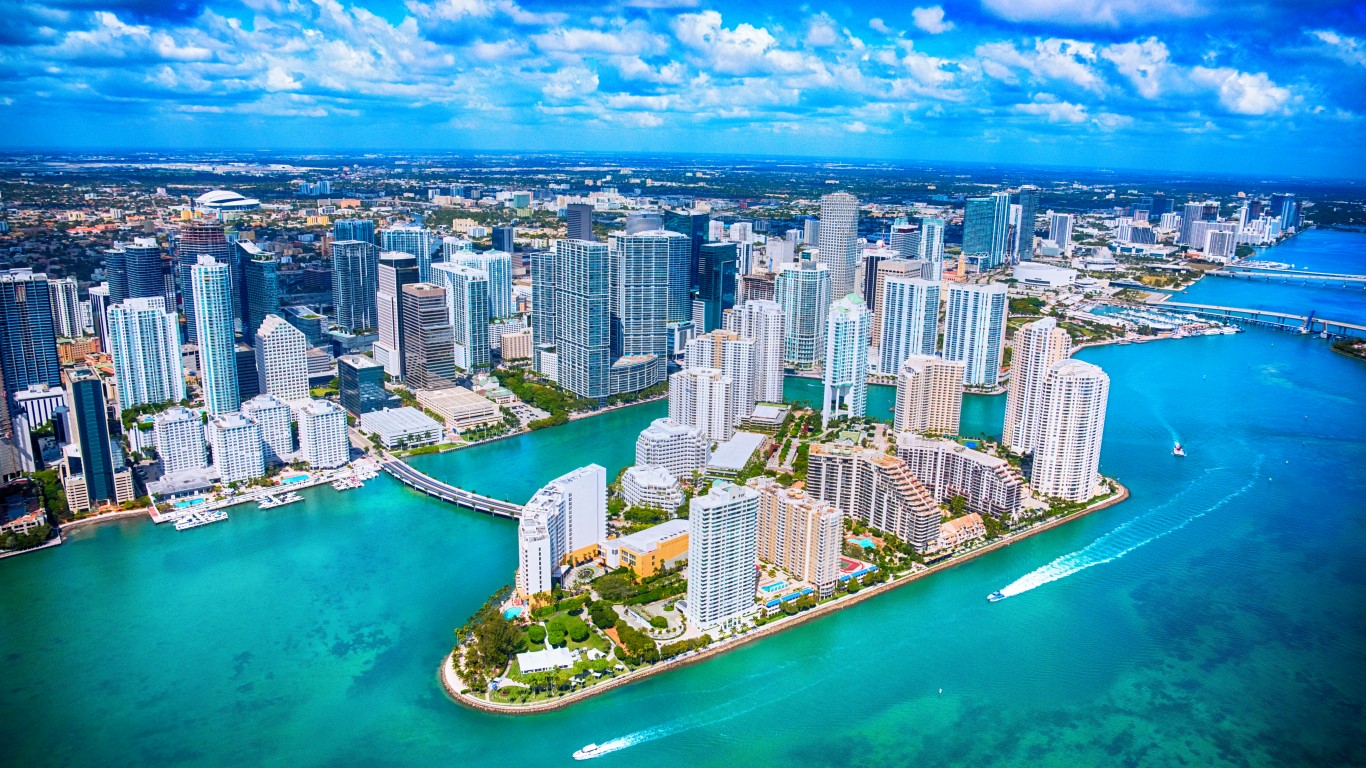
Florida: Miami-Fort Lauderdale-Pompano Beach
Avg. new daily cases in Miami in week ending June 28: 59.6 per 100,000
Avg. new daily cases in Miami in week ending June 21: 58.8 per 100,000
COVID-19 cases in Miami as of June 28: 2,379,241 (39,063.8 per 100,000)
Peak pandemic unemployment in Miami: 13.8% (April 2020)
Miami population: 6,090,660 (1,199.6 people per sq. mi.)

Georgia: Savannah
Avg. new daily cases in Savannah in week ending June 28: 30.6 per 100,000
Avg. new daily cases in Savannah in week ending June 21: 31.8 per 100,000
COVID-19 cases in Savannah as of June 28: 90,854 (23,535.1 per 100,000)
Peak pandemic unemployment in Savannah: 15.7% (April 2020)
Savannah population: 386,036 (288.1 people per sq. mi.)

Hawaii: Urban Honolulu
Avg. new daily cases in Urban Honolulu in week ending June 28: 61.1 per 100,000
Avg. new daily cases in Urban Honolulu in week ending June 21: 78.7 per 100,000
COVID-19 cases in Urban Honolulu as of June 28: 210,633 (21,387.9 per 100,000)
Peak pandemic unemployment in Urban Honolulu: 20.7% (April 2020)
Urban Honolulu population: 984,821 (1,639.3 people per sq. mi.)
These are all the counties in Hawaii where COVID-19 is slowing (and where it’s still getting worse).

Idaho: Boise City
Avg. new daily cases in Boise City in week ending June 28: 23.4 per 100,000
Avg. new daily cases in Boise City in week ending June 21: 25.5 per 100,000
COVID-19 cases in Boise City as of June 28: 210,293 (29,587.8 per 100,000)
Peak pandemic unemployment in Boise City: 12.6% (April 2020)
Boise City population: 710,743 (60.4 people per sq. mi.)
These are all the counties in Idaho where COVID-19 is slowing (and where it’s still getting worse).
Illinois: Danville
Avg. new daily cases in Danville in week ending June 28: 45.4 per 100,000
Avg. new daily cases in Danville in week ending June 21: 30.2 per 100,000
COVID-19 cases in Danville as of June 28: 29,347 (37,836.3 per 100,000)
Peak pandemic unemployment in Danville: 18.4% (April 2020)
Danville population: 77,563 (86.3 people per sq. mi.)

Indiana: Evansville, IN-KY
Avg. new daily cases in Evansville in week ending June 28: 25.4 per 100,000
Avg. new daily cases in Evansville in week ending June 21: 20.7 per 100,000
COVID-19 cases in Evansville as of June 28: 101,398 (32,193.9 per 100,000)
Peak pandemic unemployment in Evansville: 15.2% (April 2020)
Evansville population: 314,960 (215.1 people per sq. mi.)

Iowa: Iowa City
Avg. new daily cases in Iowa City in week ending June 28: 25.3 per 100,000
Avg. new daily cases in Iowa City in week ending June 21: 30.8 per 100,000
COVID-19 cases in Iowa City as of June 28: 43,900 (25,721.1 per 100,000)
Peak pandemic unemployment in Iowa City: 10.1% (April 2020)
Iowa City population: 170,677 (144.3 people per sq. mi.)
These are all the counties in Iowa where COVID-19 is slowing (and where it’s still getting worse).

Kansas: Lawrence
Avg. new daily cases in Lawrence in week ending June 28: 33.0 per 100,000
Avg. new daily cases in Lawrence in week ending June 21: 30.8 per 100,000
COVID-19 cases in Lawrence as of June 28: 28,874 (24,003.7 per 100,000)
Peak pandemic unemployment in Lawrence: 12.1% (April 2020)
Lawrence population: 120,290 (263.9 people per sq. mi.)
These are all the counties in Kansas where COVID-19 is slowing (and where it’s still getting worse).

Kentucky: Lexington-Fayette
Avg. new daily cases in Lexington in week ending June 28: 39.5 per 100,000
Avg. new daily cases in Lexington in week ending June 21: 46.8 per 100,000
COVID-19 cases in Lexington as of June 28: 161,474 (31,621.5 per 100,000)
Peak pandemic unemployment in Lexington: 15.8% (April 2020)
Lexington population: 510,647 (347.7 people per sq. mi.)
Louisiana: Houma-Thibodaux
Avg. new daily cases in Houma in week ending June 28: 36.3 per 100,000
Avg. new daily cases in Houma in week ending June 21: 31.4 per 100,000
COVID-19 cases in Houma as of June 28: 57,931 (27,564.9 per 100,000)
Peak pandemic unemployment in Houma: 13.1% (April 2020)
Houma population: 210,162 (91.4 people per sq. mi.)

Maine: Lewiston-Auburn
Avg. new daily cases in Lewiston in week ending June 28: 13.3 per 100,000
Avg. new daily cases in Lewiston in week ending June 21: 13.5 per 100,000
COVID-19 cases in Lewiston as of June 28: 24,192 (22,482.9 per 100,000)
Peak pandemic unemployment in Lewiston: 10.3% (July 2020)
Lewiston population: 107,602 (230.0 people per sq. mi.)
These are all the counties in Maine where COVID-19 is slowing (and where it’s still getting worse).

Maryland: Salisbury, MD-DE
Avg. new daily cases in Salisbury in week ending June 28: 19.8 per 100,000
Avg. new daily cases in Salisbury in week ending June 21: 19.6 per 100,000
COVID-19 cases in Salisbury as of June 28: 101,929 (25,203.9 per 100,000)
Peak pandemic unemployment in Salisbury: 16.0% (April 2020)
Salisbury population: 404,417 (192.7 people per sq. mi.)

Massachusetts: Pittsfield
Avg. new daily cases in Pittsfield in week ending June 28: 20.8 per 100,000
Avg. new daily cases in Pittsfield in week ending June 21: 23.6 per 100,000
COVID-19 cases in Pittsfield as of June 28: 28,642 (22,655.3 per 100,000)
Peak pandemic unemployment in Pittsfield: 18.3% (June 2020)
Pittsfield population: 126,425 (136.4 people per sq. mi.)

Michigan: Ann Arbor
Avg. new daily cases in Ann Arbor in week ending June 28: 25.6 per 100,000
Avg. new daily cases in Ann Arbor in week ending June 21: 40.9 per 100,000
COVID-19 cases in Ann Arbor as of June 28: 89,543 (24,398.6 per 100,000)
Peak pandemic unemployment in Ann Arbor: 15.5% (April 2020)
Ann Arbor population: 367,000 (519.9 people per sq. mi.)

Minnesota: Duluth, MN-WI
Avg. new daily cases in Duluth in week ending June 28: 20.0 per 100,000
Avg. new daily cases in Duluth in week ending June 21: 26.6 per 100,000
COVID-19 cases in Duluth as of June 28: 75,908 (26,243.3 per 100,000)
Peak pandemic unemployment in Duluth: 12.9% (May 2020)
Duluth population: 289,247 (27.5 people per sq. mi.)

Mississippi: Hattiesburg
Avg. new daily cases in Hattiesburg in week ending June 28: 30.8 per 100,000
Avg. new daily cases in Hattiesburg in week ending June 21: 24.1 per 100,000
COVID-19 cases in Hattiesburg as of June 28: 51,118 (30,395.4 per 100,000)
Peak pandemic unemployment in Hattiesburg: 13.3% (April 2020)
Hattiesburg population: 168,177 (83.1 people per sq. mi.)
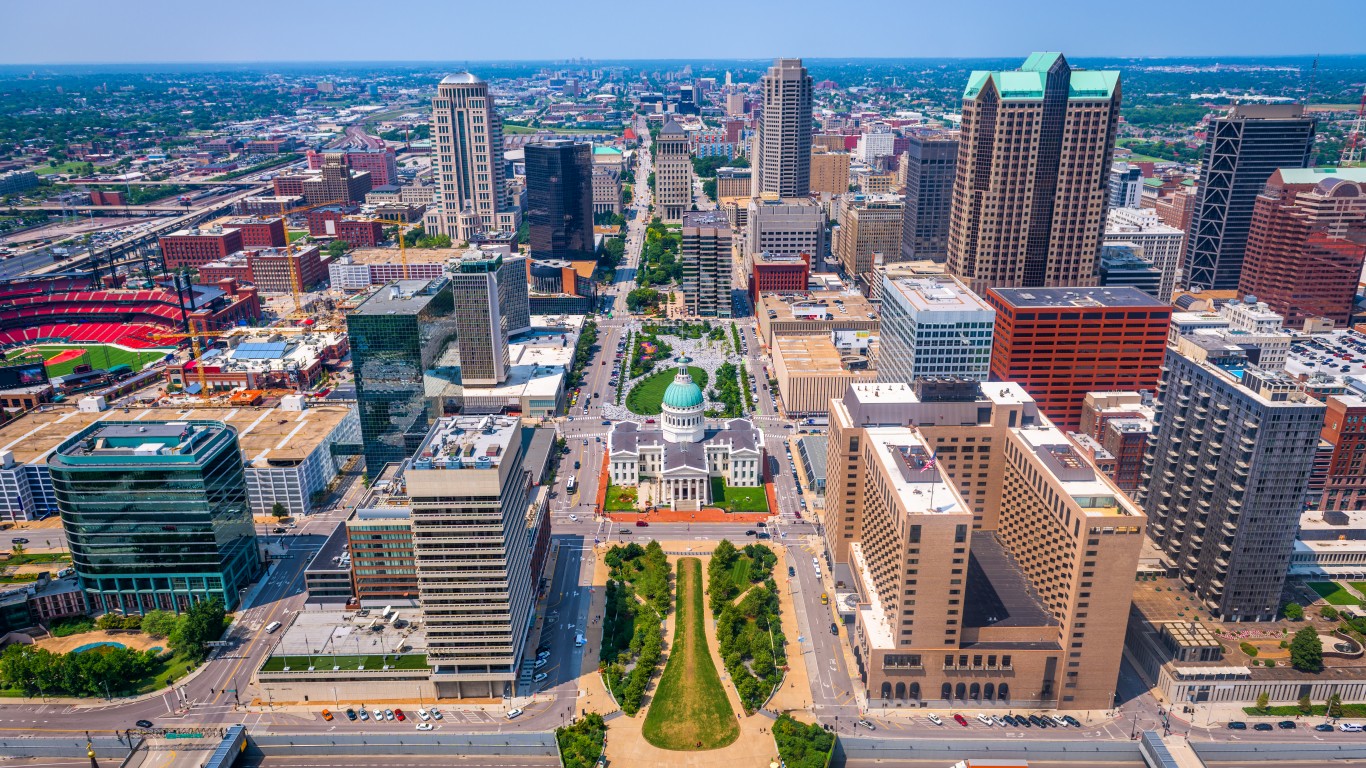
Missouri: St. Louis, MO-IL
Avg. new daily cases in St. Louis in week ending June 28: 30.5 per 100,000
Avg. new daily cases in St. Louis in week ending June 21: 31.1 per 100,000
COVID-19 cases in St. Louis as of June 28: 703,346 (25,073.0 per 100,000)
Peak pandemic unemployment in St. Louis: 11.6% (April 2020)
St. Louis population: 2,805,190 (356.7 people per sq. mi.)

Montana: Missoula
Avg. new daily cases in Missoula in week ending June 28: 31.0 per 100,000
Avg. new daily cases in Missoula in week ending June 21: 28.4 per 100,000
COVID-19 cases in Missoula as of June 28: 28,939 (24,669.0 per 100,000)
Peak pandemic unemployment in Missoula: 13.3% (April 2020)
Missoula population: 117,309 (45.2 people per sq. mi.)

Nebraska: Grand Island
Avg. new daily cases in Grand Island in week ending June 28: 23.8 per 100,000
Avg. new daily cases in Grand Island in week ending June 21: 21.1 per 100,000
COVID-19 cases in Grand Island as of June 28: 19,777 (26,201.6 per 100,000)
Peak pandemic unemployment in Grand Island: 11.4% (April 2020)
Grand Island population: 75,480 (47.2 people per sq. mi.)

Nevada: Las Vegas-Henderson-Paradise
Avg. new daily cases in Las Vegas in week ending June 28: 38.5 per 100,000
Avg. new daily cases in Las Vegas in week ending June 21: 42.8 per 100,000
COVID-19 cases in Las Vegas as of June 28: 575,701 (26,384.0 per 100,000)
Peak pandemic unemployment in Las Vegas: 34.2% (April 2020)
Las Vegas population: 2,182,004 (276.5 people per sq. mi.)
These are all the counties in Nevada where COVID-19 is slowing (and where it’s still getting worse).

New Hampshire: Manchester-Nashua
Avg. new daily cases in Manchester in week ending June 28: 15.3 per 100,000
Avg. new daily cases in Manchester in week ending June 21: 16.8 per 100,000
COVID-19 cases in Manchester as of June 28: 106,268 (25,728.6 per 100,000)
Peak pandemic unemployment in Manchester: 17.5% (April 2020)
Manchester population: 413,035 (471.4 people per sq. mi.)

New Jersey: Trenton-Princeton
Avg. new daily cases in Trenton in week ending June 28: 30.9 per 100,000
Avg. new daily cases in Trenton in week ending June 21: 28.7 per 100,000
COVID-19 cases in Trenton as of June 28: 87,455 (23,770.0 per 100,000)
Peak pandemic unemployment in Trenton: 12.4% (June 2020)
Trenton population: 367,922 (1,638.4 people per sq. mi.)

New Mexico: Farmington
Avg. new daily cases in Farmington in week ending June 28: 50.0 per 100,000
Avg. new daily cases in Farmington in week ending June 21: 41.2 per 100,000
COVID-19 cases in Farmington as of June 28: 42,616 (33,684.5 per 100,000)
Peak pandemic unemployment in Farmington: 14.5% (July 2020)
Farmington population: 126,515 (22.9 people per sq. mi.)

New York: New York-Newark-Jersey City, NY-NJ-PA
Avg. new daily cases in New York in week ending June 28: 30.0 per 100,000
Avg. new daily cases in New York in week ending June 21: 31.9 per 100,000
COVID-19 cases in New York as of June 28: 5,775,194 (29,932.2 per 100,000)
Peak pandemic unemployment in New York: 17.2% (June 2020)
New York population: 19,294,236 (2,885.4 people per sq. mi.)

North Carolina: Greenville
Avg. new daily cases in Greenville in week ending June 28: 52.9 per 100,000
Avg. new daily cases in Greenville in week ending June 21: 33.9 per 100,000
COVID-19 cases in Greenville as of June 28: 55,642 (31,183.7 per 100,000)
Peak pandemic unemployment in Greenville: 10.5% (April 2020)
Greenville population: 178,433 (273.7 people per sq. mi.)

North Dakota: Bismarck
Avg. new daily cases in Bismarck in week ending June 28: 29.8 per 100,000
Avg. new daily cases in Bismarck in week ending June 21: 15.8 per 100,000
COVID-19 cases in Bismarck as of June 28: 47,575 (37,312.8 per 100,000)
Peak pandemic unemployment in Bismarck: 9.5% (April 2020)
Bismarck population: 127,503 (29.8 people per sq. mi.)
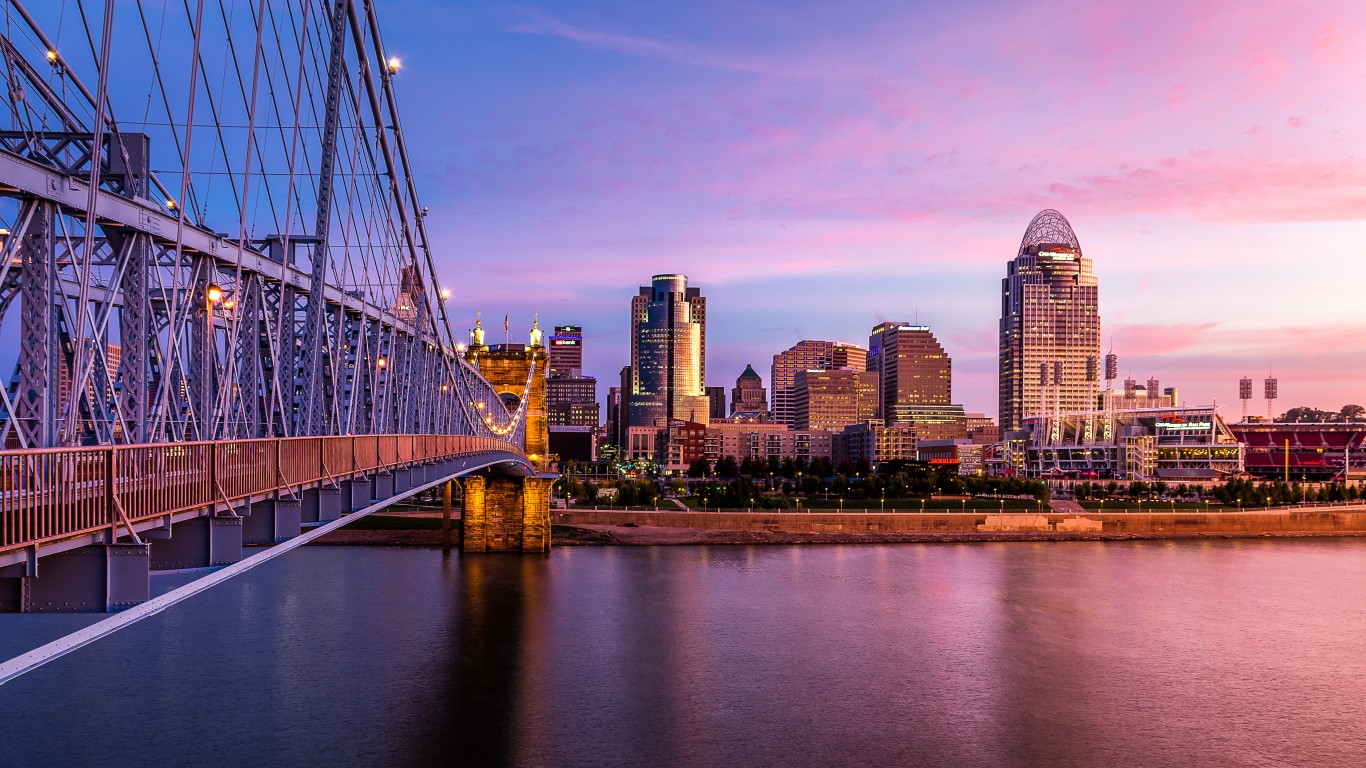
Ohio: Cincinnati, OH-KY-IN
Avg. new daily cases in Cincinnati in week ending June 28: 20.4 per 100,000
Avg. new daily cases in Cincinnati in week ending June 21: 24.9 per 100,000
COVID-19 cases in Cincinnati as of June 28: 566,390 (25,724.6 per 100,000)
Peak pandemic unemployment in Cincinnati: 14.5% (April 2020)
Cincinnati population: 2,201,741 (483.6 people per sq. mi.)
These are all the counties in Ohio where COVID-19 is slowing (and where it’s still getting worse).

Oklahoma: Oklahoma City
Avg. new daily cases in Oklahoma City in week ending June 28: 19.1 per 100,000
Avg. new daily cases in Oklahoma City in week ending June 21: 15.6 per 100,000
COVID-19 cases in Oklahoma City as of June 28: 371,263 (26,847.8 per 100,000)
Peak pandemic unemployment in Oklahoma City: 15.2% (April 2020)
Oklahoma City population: 1,382,841 (250.9 people per sq. mi.)

Oregon: Bend
Avg. new daily cases in Bend in week ending June 28: 43.4 per 100,000
Avg. new daily cases in Bend in week ending June 21: 44.0 per 100,000
COVID-19 cases in Bend as of June 28: 51,623 (27,716.9 per 100,000)
Peak pandemic unemployment in Bend: 18.3% (April 2020)
Bend population: 186,251 (61.7 people per sq. mi.)
These are all the counties in Oregon where COVID-19 is slowing (and where it’s still getting worse).

Pennsylvania: Chambersburg-Waynesboro
Avg. new daily cases in Chambersburg in week ending June 28: 21.0 per 100,000
Avg. new daily cases in Chambersburg in week ending June 21: 20.2 per 100,000
COVID-19 cases in Chambersburg as of June 28: 42,222 (27,390.7 per 100,000)
Peak pandemic unemployment in Chambersburg: 13.3% (April 2020)
Chambersburg population: 154,147 (199.6 people per sq. mi.)

Rhode Island: Providence-Warwick, RI-MA
Avg. new daily cases in Providence in week ending June 28: 21.4 per 100,000
Avg. new daily cases in Providence in week ending June 21: 26.6 per 100,000
COVID-19 cases in Providence as of June 28: 530,027 (32,752.7 per 100,000)
Peak pandemic unemployment in Providence: 18.5% (April 2020)
Providence population: 1,618,268 (1,019.8 people per sq. mi.)

South Carolina: Columbia
Avg. new daily cases in Columbia in week ending June 28: 35.4 per 100,000
Avg. new daily cases in Columbia in week ending June 21: 36.9 per 100,000
COVID-19 cases in Columbia as of June 28: 266,114 (32,284.5 per 100,000)
Peak pandemic unemployment in Columbia: 9.4% (May 2020)
Columbia population: 824,278 (222.6 people per sq. mi.)

South Dakota: Rapid City
Avg. new daily cases in Rapid City in week ending June 28: 28.8 per 100,000
Avg. new daily cases in Rapid City in week ending June 21: 28.2 per 100,000
COVID-19 cases in Rapid City as of June 28: 41,179 (29,753.2 per 100,000)
Peak pandemic unemployment in Rapid City: 13.8% (April 2020)
Rapid City population: 138,402 (22.2 people per sq. mi.)

Tennessee: Memphis, TN-MS-AR
Avg. new daily cases in Memphis in week ending June 28: 33.2 per 100,000
Avg. new daily cases in Memphis in week ending June 21: 34.5 per 100,000
COVID-19 cases in Memphis as of June 28: 368,836 (27,532.8 per 100,000)
Peak pandemic unemployment in Memphis: 13.4% (April 2020)
Memphis population: 1,339,623 (292.6 people per sq. mi.)
Texas: Brownsville-Harlingen
Avg. new daily cases in Brownsville in week ending June 28: 38.0 per 100,000
Avg. new daily cases in Brownsville in week ending June 21: 35.4 per 100,000
COVID-19 cases in Brownsville as of June 28: 110,404 (26,182.8 per 100,000)
Peak pandemic unemployment in Brownsville: 17.6% (April 2020)
Brownsville population: 421,666 (473.3 people per sq. mi.)
These are all the counties in Texas where COVID-19 is slowing (and where it’s still getting worse).
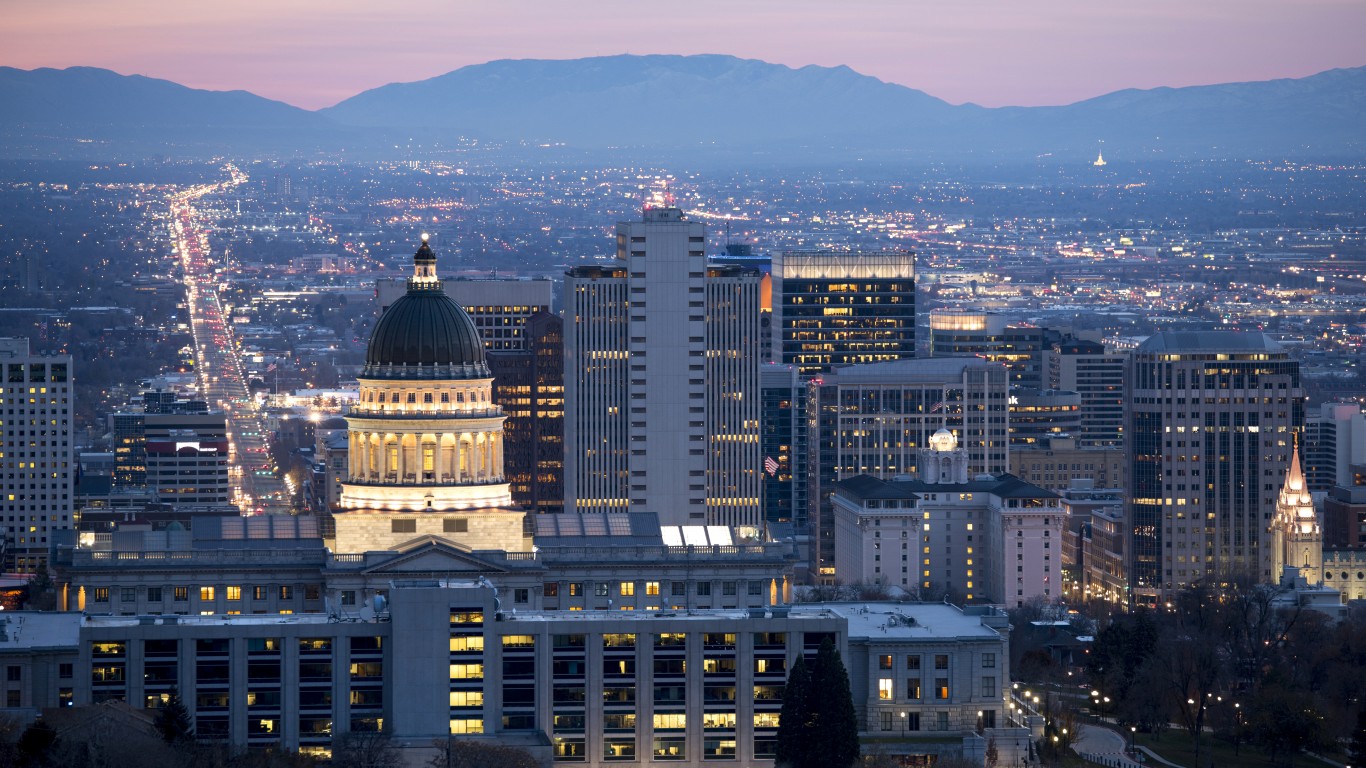
Utah: Salt Lake City
Avg. new daily cases in Salt Lake City in week ending June 28: 34.2 per 100,000
Avg. new daily cases in Salt Lake City in week ending June 21: 37.8 per 100,000
COVID-19 cases in Salt Lake City as of June 28: 383,716 (31,948.6 per 100,000)
Peak pandemic unemployment in Salt Lake City: 11.3% (April 2020)
Salt Lake City population: 1,201,043 (156.3 people per sq. mi.)
These are all the counties in Utah where COVID-19 is slowing (and where it’s still getting worse).

Vermont: Burlington-South Burlington
Avg. new daily cases in Burlington in week ending June 28: 12.4 per 100,000
Avg. new daily cases in Burlington in week ending June 21: 17.8 per 100,000
COVID-19 cases in Burlington as of June 28: 47,899 (21,893.3 per 100,000)
Peak pandemic unemployment in Burlington: 14.8% (April 2020)
Burlington population: 218,784 (174.7 people per sq. mi.)

Virginia: Lynchburg
Avg. new daily cases in Lynchburg in week ending June 28: 31.6 per 100,000
Avg. new daily cases in Lynchburg in week ending June 21: 34.4 per 100,000
COVID-19 cases in Lynchburg as of June 28: 63,996 (24,458.4 per 100,000)
Peak pandemic unemployment in Lynchburg: 10.6% (April 2020)
Lynchburg population: 261,652 (123.8 people per sq. mi.)

Washington: Seattle-Tacoma-Bellevue
Avg. new daily cases in Seattle in week ending June 28: 35.6 per 100,000
Avg. new daily cases in Seattle in week ending June 21: 37.9 per 100,000
COVID-19 cases in Seattle as of June 28: 838,858 (21,668.5 per 100,000)
Peak pandemic unemployment in Seattle: 17.3% (April 2020)
Seattle population: 3,871,323 (659.2 people per sq. mi.)

West Virginia: Huntington-Ashland, WV-KY-OH
Avg. new daily cases in Huntington in week ending June 28: 26.7 per 100,000
Avg. new daily cases in Huntington in week ending June 21: 31.3 per 100,000
COVID-19 cases in Huntington as of June 28: 114,479 (31,638.7 per 100,000)
Peak pandemic unemployment in Huntington: 17.2% (April 2020)
Huntington population: 361,832 (144.7 people per sq. mi.)

Wisconsin: Madison
Avg. new daily cases in Madison in week ending June 28: 39.4 per 100,000
Avg. new daily cases in Madison in week ending June 21: 42.5 per 100,000
COVID-19 cases in Madison as of June 28: 179,298 (27,427.1 per 100,000)
Peak pandemic unemployment in Madison: 11.6% (April 2020)
Madison population: 653,725 (197.5 people per sq. mi.)

Wyoming: Cheyenne
Avg. new daily cases in Cheyenne in week ending June 28: 31.2 per 100,000
Avg. new daily cases in Cheyenne in week ending June 21: 45.2 per 100,000
COVID-19 cases in Cheyenne as of June 28: 27,444 (27,912.9 per 100,000)
Peak pandemic unemployment in Cheyenne: 9.2% (April 2020)
Cheyenne population: 98,320 (36.6 people per sq. mi.)
Click here to see all coronavirus data for every state.
Credit card companies are pulling out all the stops, with the issuers are offering insane travel rewards and perks.
We’re talking huge sign-up bonuses, points on every purchase, and benefits like lounge access, travel credits, and free hotel nights. For travelers, these rewards can add up to thousands of dollars in flights, upgrades, and luxury experiences every year.
It’s like getting paid to travel — and it’s available to qualified borrowers who know where to look.
We’ve rounded up some of the best travel credit cards on the market. Click here to see the list. Don’t miss these offers — they won’t be this good forever.
Thank you for reading! Have some feedback for us?
Contact the 24/7 Wall St. editorial team.